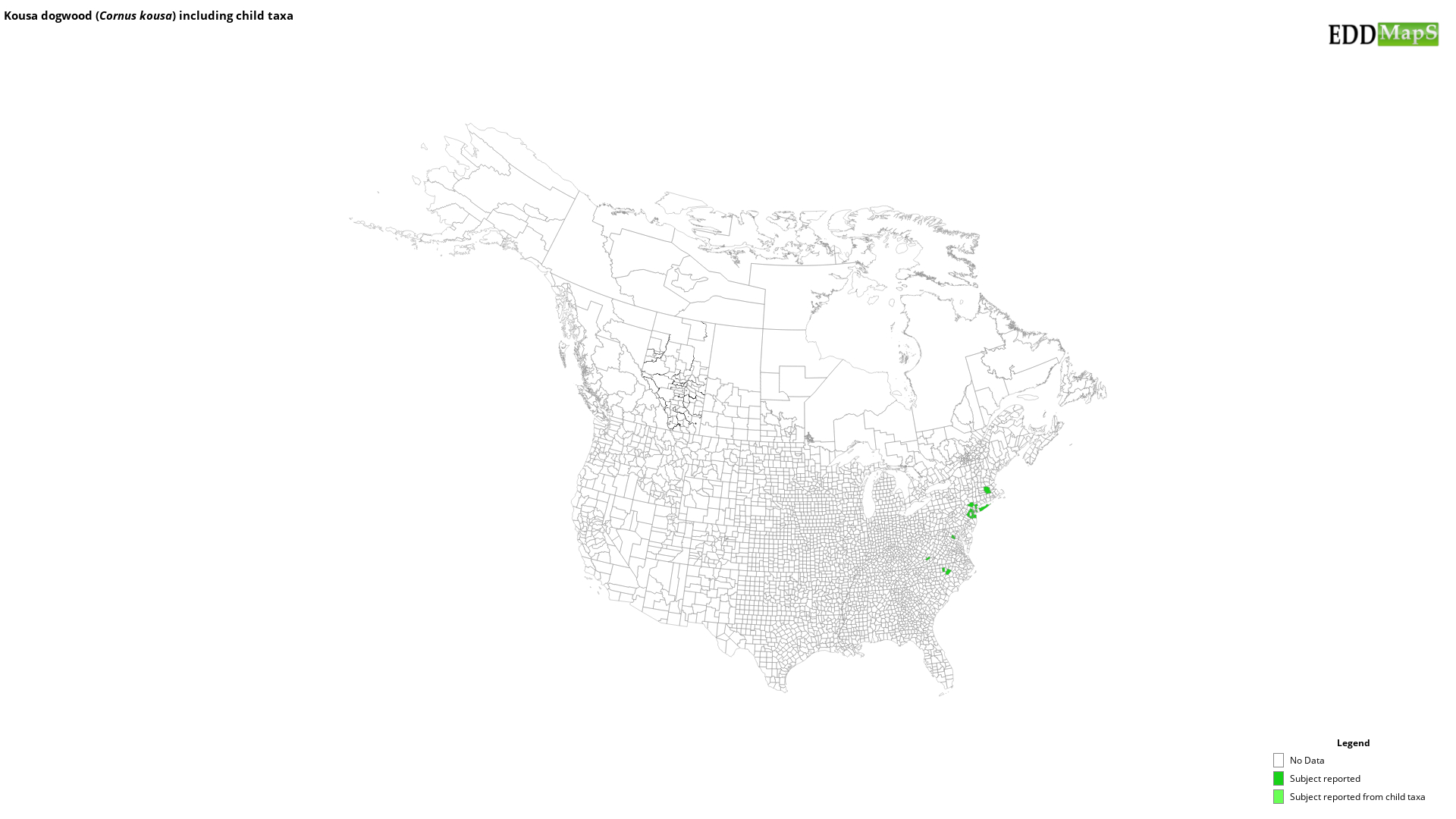Kousa dogwood
(Cornus kousa)
This species is Introduced in the United States
ORIGIN: East Asia
GROWTH TRAITS: Small deciduous tree or large multi-stemmed shrub typically growing 15-30' (4.5-9 m) tall from a far-reaching but shallow root system. Plants at first produce a vase-shaped canopy with upright branches, though branching becomes more horizontal and tiered with age, gradually creating a rounded canopy. Bark is grayish-brown and may begin peeling at maturity. Leaves are opposite, 2-4" (5-10 cm) long, up to 1" (2.5 cm) wide, and attached to the branch with long petioles. Leaves are ovate to elliptical and have smooth but sometimes wavy margins and veins that curve towards the tip. Leaves are shiny green at first and turn pink in autumn before falling to the ground for winter. Flowers are produced in late spring to early summer, arising upright from leaf axils all along branches. Flowers are tiny, green, and non-showy in central clusters. They are surrounded by 4 showy white bracts that resemble petals. Each bract is 1-2" (2.5-5 cm) long and ovate with a pointed tip. The fruits are berry-like pendants typically 1.2" (3 cm) across that resemble large raspberries when ripe. Trees generally live 15 years in cultivation but many live much longer in their native habitat.
REPRODUCTION: Spreads by seed. Many seeds remain viable for up to 3 years.
HABITAT: Capitalizes on disturbance or intentional planting to establish initially, but can then spread into undisturbed areas. It grows well in full sun to partial shade and prefers moist, well-drained soil. In North America, it can be found on forest margins and abandoned lands, and in urban gardens.
LOOK-ALIKES: The opposite leaves with veins curving toward the tip, in combination with the non-showy flowers surrounded by 4 showy white bracts, help differentiate this species from most potential look-alikes. The native flowering dogwood (Cornus florida) has similar growth form, leaves, and flowers. It differs with its flower bracts being rounded and notched at the tips, flowering earlier, and having clusters of smaller berry-like fruits that resemble rose hips rather than raspberries.
CITATIONS:
Rawlins, K.A., R.L. Winston, C.T. Bargeron, D.J. Moorhead, and R. Carroll. 2018. New Invaders of the Northeast and Northcentral United States. USDA Forest Service, Forest Health Assessment and Applied Sciences Team, Morgantown, West Virginia. FHTET-2017-04. Retrieved from https://bugwoodcloud.org/resource/pdf/FHTET-2017-04_New%20Invaders_NE.pdf
GROWTH TRAITS: Small deciduous tree or large multi-stemmed shrub typically growing 15-30' (4.5-9 m) tall from a far-reaching but shallow root system. Plants at first produce a vase-shaped canopy with upright branches, though branching becomes more horizontal and tiered with age, gradually creating a rounded canopy. Bark is grayish-brown and may begin peeling at maturity. Leaves are opposite, 2-4" (5-10 cm) long, up to 1" (2.5 cm) wide, and attached to the branch with long petioles. Leaves are ovate to elliptical and have smooth but sometimes wavy margins and veins that curve towards the tip. Leaves are shiny green at first and turn pink in autumn before falling to the ground for winter. Flowers are produced in late spring to early summer, arising upright from leaf axils all along branches. Flowers are tiny, green, and non-showy in central clusters. They are surrounded by 4 showy white bracts that resemble petals. Each bract is 1-2" (2.5-5 cm) long and ovate with a pointed tip. The fruits are berry-like pendants typically 1.2" (3 cm) across that resemble large raspberries when ripe. Trees generally live 15 years in cultivation but many live much longer in their native habitat.
REPRODUCTION: Spreads by seed. Many seeds remain viable for up to 3 years.
HABITAT: Capitalizes on disturbance or intentional planting to establish initially, but can then spread into undisturbed areas. It grows well in full sun to partial shade and prefers moist, well-drained soil. In North America, it can be found on forest margins and abandoned lands, and in urban gardens.
LOOK-ALIKES: The opposite leaves with veins curving toward the tip, in combination with the non-showy flowers surrounded by 4 showy white bracts, help differentiate this species from most potential look-alikes. The native flowering dogwood (Cornus florida) has similar growth form, leaves, and flowers. It differs with its flower bracts being rounded and notched at the tips, flowering earlier, and having clusters of smaller berry-like fruits that resemble rose hips rather than raspberries.
CITATIONS:
Rawlins, K.A., R.L. Winston, C.T. Bargeron, D.J. Moorhead, and R. Carroll. 2018. New Invaders of the Northeast and Northcentral United States. USDA Forest Service, Forest Health Assessment and Applied Sciences Team, Morgantown, West Virginia. FHTET-2017-04. Retrieved from https://bugwoodcloud.org/resource/pdf/FHTET-2017-04_New%20Invaders_NE.pdf
Selected Images
Maps
EDDMapS Distribution - This map is incomplete and is based only on current site and county level reports made by experts, herbaria, and literature. For more information, visit www.eddmaps.org
State Lists - This map identifies those states that have this species on their invasive species list or law.
Invasive Listing Sources
Taxonomic Rank
| Domain: Eukarya |
| Kingdom: Plantae |
| Phylum: Magnoliophyta |
| Class: Magnoliopsida |
| Superorder: Asteranae |
| Order: Cornales |
| Family: Cornaceae |
| Genus: Cornus |
| Cornus kousa |
References
Common Name Reference: USDA, NRCS. 2010. The PLANTS Database. National Plant Data Center, Baton Rouge, LA, USA.
Scientific Name Reference: USDA, NRCS. 2010. The PLANTS Database. National Plant Data Center, Baton Rouge, LA, USA.


